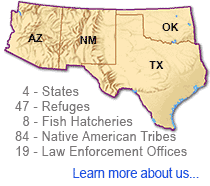Tribal Assistance Trout Production, Stocking and Conservation In any given year in Arizona, state and federal hatcheries produce approximately 4,900,000 trout, and anglers produce an estimated $831,500,000 in economic impact. Through permits to fish on tribal lands, a large portion of this total, represent a significant source of income for tribes in the state. Limited in budget and staff, the tribes benefit from the help of partners in managing their fisheries resources, including the four million sport fish annually stocked through coordination of the AZFWCO staff in conjunction with the National Fish Hatchery System. We also assist tribes with development of sportfishing opportunities, and we provide technical assistance, management recommendations, and advice on law enforcement issues to sportfish management. Colorado River Indian Tribes Tribal Assistance A long time partner of the Service, the Colorado River Indian Tribes (CRIT) owns and manages lands that contain important habitat in the lower Colorado River ecosystem. However, the tribes do not have the staff, equipment, or training to pursue all of the conservation work that they would like to. We provide assistance to the tribes in managing approximately 45 miles of the Colorado River, 60 miles of canals, and five impoundments. With the assistance of the Southwestern Native Aquatic Resources and Recovery Center we also conduct wild fish health surveys of the Colorado River within the border of the CRIT. The AZFWCO staff also assisted in the creation of a draft Memorandum of Agreement for the operation of the Achii Hanyo native fish facility, which is a satellite location for the Willow Beach NFH. White Mountain Apache Fisheries With more than 800 miles of streams and 2,300 acres of lakes, the Fort Apache Indian Reservation supports more than one third of the cod-water fisher resources in the state of Arizona. These waters provide and important economic resource for the White Mountain Apache Tribe via the sale of fishing permits. The AZFWCO office is proud to be able to routinely provide technical assistance to White Mountain Apache Tribe to aid in managing its fishery resources. The AZFWCO staff assist with brown trout removal efforts, Apache trout population surveys, electrofishing surveys of largemouth bass and channel catfish, assisting with their annual Youth Fishing Derby, and stocking fish received from the National Fish Hatchery system.. Surveys of Fort Apache Indian Reservation Lakes AZFWCO assists with surveys of Fort Apache Indian Reservation Lakes. AZFWCO and White Mountain Apache Tribe, Wildlife and Outdoor Recreation Division personnel completed spring surveys of 5 high-elevation trout lakes located on the Fort Apache Indian Reservation to evaluate the fish community found within each lake and where feasible, develop recommendations for future management of each species found within. Each lake is stocked with varying combinations of trout species and managed as put-and-take, put-grow-and-take, and/or “trophy” catch and release depending upon lake-specific management goals. San Carlos Apache Fisheries Like their White Mountain Apache neighbors, the San Carlos Apache Tribe hosts a variety of recreational fishing opportunities that represent an important source of economic revenue. By working closely with the San Carlos Recreation and Wildlife Department the AZFWCO conducts annual lake electrofishing surveys on the reservation. Navajo Fisheries and Wildlife AZFWCO staff work with Navajo Nation Fish and Wildlife Department personnel to conduct fishery surveys of the Tsaile Creek watershed. The possibility of reintroducing Colorado River cutthroat trout within the Tsaile, Wheatfield, and Whiskey Creek watersheds is also being examined. AZFWCO staff have also assisted with the construction of a wetland on the Navajo Nation. A project sponsored by the Navajo Nation Department of Agriculture and Bat Conservation International, the wetland will provide benefits for amphibians, bats, grassland birds, and waterfowl. |
Accomplishments
Documents
|

